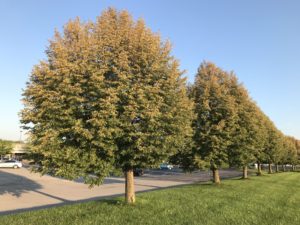 Damage caused by defoliating insects can be quite shocking. An effective response to this sort of defoliation should be based on your understanding of how losing leaves affects plant health.
Damage caused by defoliating insects can be quite shocking. An effective response to this sort of defoliation should be based on your understanding of how losing leaves affects plant health.
Leaves are little power plants that turn sunlight, carbon dioxide and water into sugar. Some of the sugar is used by the plant to fuel the production of new leaves, stems and roots, flowers and fruits. The rest of the sugar is stored as starch for use in spring to help spur new growth. Deciduous trees like oaks and maples lose their leaves each fall. Most of the starch is stored in the stem, trunk and roots. Evergreens, like pines, hollies and boxwoods, store a substantial part of these reserves in leaves.
Defoliation by caterpillars and sawflies will often kill evergreen plants, because losing leaves robs plants of both their energy factories and the reserves they need to product new plants. Deciduous plants can draw on their reserves to put out new leaves and replace their energy making factories. The ability of a deciduous tree to survive defoliation depends on the amount of leaves that have been removed, when defoliation occurs and the health of the tree prior to defoliation.
How much defoliation can be tolerated by a deciduous tree?
Healthy trees that have lost less than half of their leaves will usually survive. Healthy trees losing more than half the leaves can survive defoliation 2-3 years in a row. If trees are stressed by drought or excessive heat from city pavement or poor site conditions they are less likely to survive repeated defoliation.
Early season defoliators, like spongy (previously gypsy) moths, and eastern tent caterpillars that remove leaves within 6 weeks after bud break will allow a tree to put on a second flush of growth that can help it survive the next year. Mid-season defoliators, like bagworm and Japanese beetles can give trees less time to recover if they put on a second flush of leaves. Also the new growth may not have enough time to harden off before the winter. Late season defoliators like fall webworm, and second generation mimosa webworm are less of a problem to trees because they are removing leaves just a few weeks before normal leaf drop.
When is the best time to control a defoliator and how should it be controlled?
Adult defoliators like Japanese beetles can be controlled with insecticides early in their flight period and as needed to reduce damage ( See PLR 18-10 https://www.purduelandscapereport.org//article/japanese-beetles-are-baack/)
Caterpillars and sawflies with only one generation per year can often be controlled by a single application of pesticide before larvae become one inch long. It is better to control them with selective products like spinosad or Acelepryn, because they conserve natural enemies that protect the plants from having problems with scale insects and spider mites.
For more information about the susceptibility of deciduous trees to defoliation, see this original article by Philip Wargo http://horticulture.oregonstate.edu/system/files/onn030213.pdf
For information on other defoliators, please see these links.
Spongy moth in Indiana https://extension.entm.purdue.edu/GM/index.php?page=management
Fall Webworm https://extension.entm.purdue.edu/publications/E-255/E-255.html
Bagworm https://extension.entm.purdue.edu/publications/E-27/E-27.html
Mimosa webworm https://extension.entm.purdue.edu/publications/E-11/E-11.html